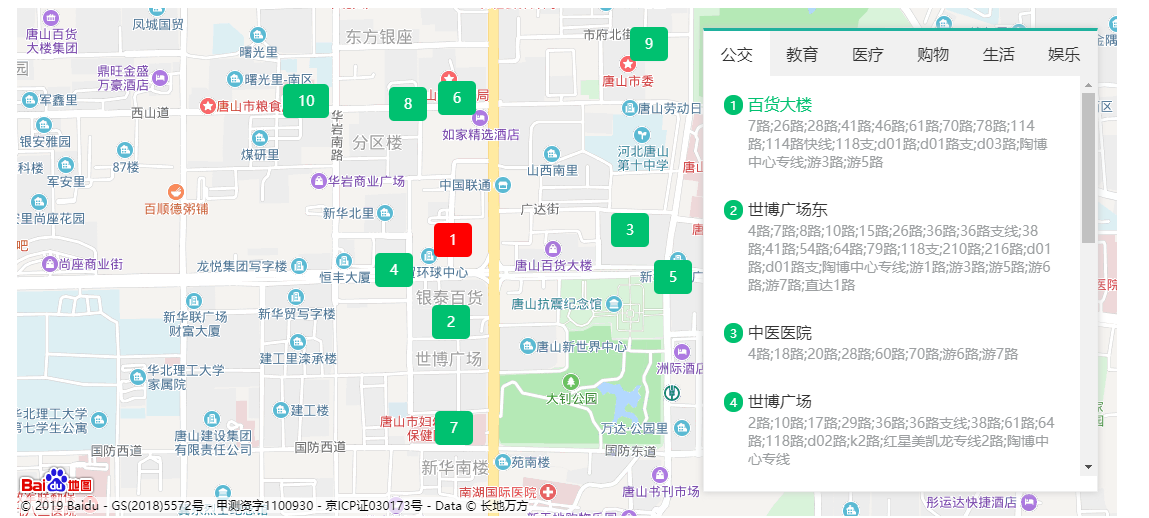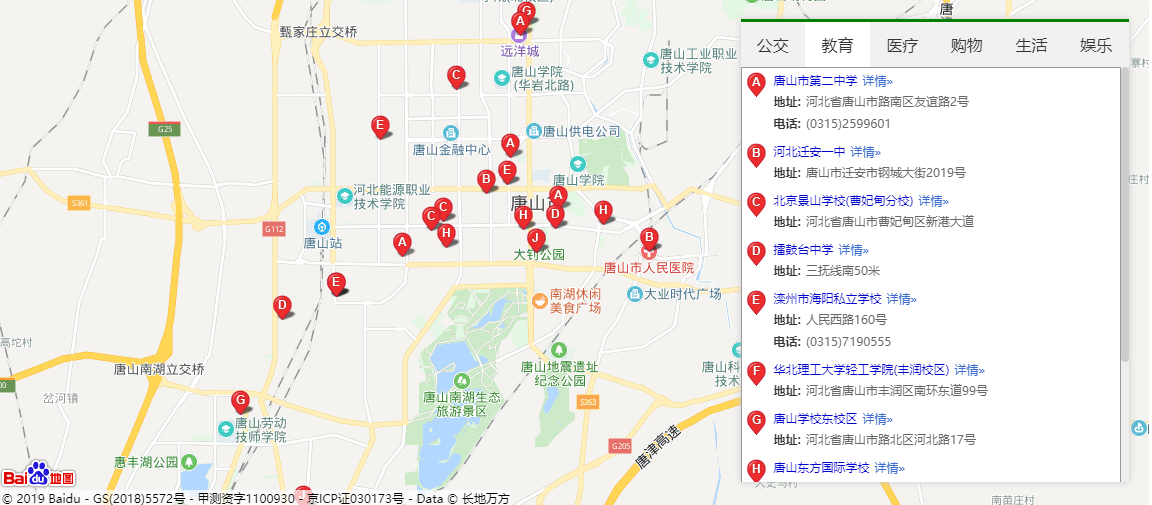最近项目需要实现地图功能,以便于实现对房源周边配套设施的检索。内容如下

其实百度官方有对应的api,但是对于一个网站来说这样的样式难免有些难看

这样的结果显然不能满足当下的需求,所以我决定利用官方给的web服务接口加上覆盖物实现对应的效果。
由于我们用的vue框架,所以我采用了基于百度地图封装的插件:vue-baidu-map 实现,对应版本号是:0.21.18,项目安装依赖如下:
npm install vue-baidu-map --save
然后在main.js中注入依赖即可:
import BaiduMap from 'vue-baidu-map'
Vue.use(BaiduMap, {
ak: '申请的百度秘钥'
})
这里的ak需要去官方申请秘钥,地址在这里,需要注意的是,申请完成之后会给你两个秘钥,我们需要给调起服务主机的ip加到白名单里,不然会有访问权限错误,由于现在是开发环境,所以我设置的是通配符*,也就是所有的主机,但是正是环境就不推荐这么做了,原因是前端代码容易泄露AK,被其他网站非法调用。
打开控制台,步骤如下:


白名单设置好以后,就能开始调用web服务了;
首先要注意一个问题,由于同源策略,我们直接调用百度官方的接口会出现跨域问题,关于什么是跨域,这里不多解释。那么前端处理跨域最理想的方案是jsonp,也就是利用script天生的优势(他可以动态获取src属性),那么vue项目不同于传统html,所以这里我用到了一个插件,也就是vue-jsonp,他是一个基于promise封装的请求库,使用方法也很简单,具体如下:
首先是安装:
npm install vue-jsonp --save
安装完成之后注入要vue实例中:
import jsonp from "vue-jsonp" Vue.use(jsonp)
使用起来也很方便:
this.$jsonp('url',params).then(()=> {
// 成功之后的回调
}).catch(() => {
// 失败之后的回调
})
下面就正是开始搭建地图了,首先开始写地图容器,按照vue-baidu-map官方的方法构建即可,注意要开启滚轮操作,还要设置地图展开的深度zoom
<template>
<div class="map-plus">
<!-- 地图容器 -->
<baidu-map
class="baidu-map"
id="map"
:double-click-zoom="false"
:min-zoom="10"
:max-zoom="18"
:scroll-wheel-zoom="true"
:center="center"
:zoom="zoom"
@ready="handler">
</baidu-map>
</div>
</template>
<script>
export default {
methods: {
// 地图组件渲染完毕时触发
handler({ BMap, map }) {
this.center.lng = 118.186882019043;
this.center.lat = 39.63203811645508;
this.zoom = 16;
}
}
};
</script>
<style lang="scss">
.map-plus {
position: relative;
}
#map {
1100px;
height: 508px;
margin-top: 200px;
margin-left: 50px;
}
</style>
这里我想主要说一下覆盖物的封装:
首先由于左右是一个联动的过程,这里我的思路是按照索引,也就是设置一个激活的索引,如果和当前点击的索引一样的话实现激活效果,还有一点体验性的问题,由于我想点击某个漂浮物的时候让该漂浮物回到地图中间,所以每次点击我根据百度服务给的经纬度赋值给当前地图的中心,覆盖物的封装如下:
<template>
<bm-overlay
ref="customOverlay"
class="happy-layer"
pane="labelPane"
@draw="draw">
<div class="content"
:class="{active: busActiveIndex == title+1}"
@click="handleClick">
{{title+1}}
</div>
</bm-overlay>
</template>
<script>
export default {
props: [
// 位置
'position',
// 是否激活
'active',
// 内容
'title',
// 激活的索引
'busActiveIndex'
],
watch: {
position: {
handler () {
this.$refs.customOverlay.reload()
},
deep: true
}
},
methods: {
handleClick () {
this.$emit('change',this.title)
},
draw ({el, BMap, map}) {
const {lng, lat} = this.position
const pixel = map.pointToOverlayPixel(new BMap.Point(lng, lat))
el.style.left = pixel.x - 60 + 'px'
el.style.top = pixel.y - 20 + 'px'
}
}
}
</script>
<style lang="scss">
.happy-layer {
position: absolute;
z-index: 99;
&:hover {
z-index: 999;
}
}
.content {
padding: 10px 15px;
font-size: 14px;
color: #fff;
background-color: #00c170;
cursor: pointer;
border-radius: 5px;
&:hover {
background-color: red;
}
}
.active {
background-color: red;
}
</style>
调用他就比较简单了,只要把从服务端拿到的结果遍历一下绑定到组件上就行了
<happy-layer v-for="(item,index) in layerList" :key=index
:position="{lng: item.location.lng , lat: item.location.lat}"
:title=index
:busActiveIndex="busActiveIndex"
@change="overLayClick"></happy-layer>
关于获取周边配套,我用到两个方法,一个负责接收参数调用服务,另一个负责获取数据
// 获取周边接口
getRound: function (key) {
let ak = "F7XhtYsBvOZeQUbrmCCuy0KGNVCZApB8";
return this.$jsonp(`http://api.map.baidu.com/place/v2/search?query=${key}&location=39.63203811645508,118.186882019043&radius=2000&output=json&ak=${ak}`)
},
// 获取周边信息
getMsg: function(a) {
this.getRound(a).then(res => {
this.layerList = []
res.results.forEach(el => el.location && this.layerList.push(el));
});
},
最后就剩下列表的搭建了,这个就不说了,直接上源码吧:
地图容器父组件:
<template>
<div class="map-plus">
<!-- 地图容器 -->
<baidu-map
class="baidu-map"
id="map"
:double-click-zoom="false"
:min-zoom="10"
:max-zoom="18"
:scroll-wheel-zoom="true"
:center="center"
:zoom="zoom"
@ready="handler">
<!-- 覆盖物组件 -->
<happy-layer v-for="(item,index) in layerList" :key=index
:position="{lng: item.location.lng , lat: item.location.lat}"
:title=index
:busActiveIndex="busActiveIndex"
@change="overLayClick"></happy-layer>
</baidu-map>
<!-- 右侧搜索 -->
<div class="search-wrap">
<!-- 标签 -->
<div class="tags">
<div class="tag_item"
:class="{'tag-active': activeIndex == index}"
v-for="(item,index) in tagsArr"
:key="index"
@click="tagsClick(index,item)">{{item.name}}</div>
</div>
<!-- 列表 -->
<div class="list">
<div class="list-top"
v-for="(bus,indexs) in layerList"
:key="indexs"
@click="chooseListItem(bus,indexs)">
<div class="title"
:class="{'active-bus': busActiveIndex == indexs+1}">
<span class="indexs">{{indexs+1}}</span>
<span>{{bus.name}}</span>
</div>
<div class="bus-num">
{{bus.address}}
</div>
</div>
</div>
</div>
</div>
</template>
<script>
export default {
data() {
return {
active: false,
// 左边中心
center: { lng: 0, lat: 0 },
// 深度
zoom: 3,
// 标签激活索引
activeIndex: 0,
// 漂浮物激活索引
busActiveIndex:1,
// 数据结果
layerList: [],
// 标签数组
tagsArr: [
{
name: "公交"
},
{
name: "教育"
},
{
name: "医疗"
},
{
name: "购物"
},
{
name: "生活"
},
{
name: "娱乐"
}
]
};
},
mounted() {
this.getMsg('公交');
},
methods: {
// 地图组件渲染完毕时触发
handler({ BMap, map }) {
this.center.lng = 118.186882019043;
this.center.lat = 39.63203811645508;
this.zoom = 16;
},
// 标签激活
tagsClick: function(index, item) {
this.activeIndex = index
this.getMsg(item.name)
},
// 获取周边接口
getRound: function (key) {
let ak = 你申请的秘钥;
return this.$jsonp(`http://api.map.baidu.com/place/v2/search?query=${key}&location=39.63203811645508,118.186882019043&radius=2000&output=json&ak=${ak}`)
},
// 获取周边信息
getMsg: function(a) {
this.getRound(a).then(res => {
this.layerList = []
res.results.forEach(el => el.location && this.layerList.push(el));
});
},
// 覆盖物点击激活
overLayClick: function (num) {
this.busActiveIndex = num + 1
},
// 选择列表某一项
chooseListItem: function (bus,indexs) {
this.busActiveIndex = indexs+1
this.center = bus.location
}
}
};
</script>
<style lang="scss">
.map-plus {
position: relative;
}
#map {
1100px;
height: 508px;
margin-top: 200px;
margin-left: 50px;
}
.search-wrap {
393px;
height: 460px;
border: 1px solid #eee;
background-color: #fff;
position: absolute;
left: 736px;
top: 220px;
box-shadow: 0 0 10px #ccc;
border-top: 3px solid #1fb19e;
.list {
height: 400px;
overflow-y: scroll;
.list-top {
color: #333;
padding: 20px 20px 10px 20px;
cursor: pointer;
.indexs {
padding: 2px 6px;
font-size: 12px;
border-radius: 50%;
background-color: #00c170;
color: #fff;
}
&:hover {
color: #00c170;
}
.bus-num {
font-size: 14px;
margin: 5px 0 0 24px;
color: #9c9fa1;
line-height: 18px;
}
}
}
.active-bus {
color: #00c170;
}
.tags {
line-height: 45px;
height: 45px;
background-color: #f1f1f1;
display: flex;
justify-content: space-between;
.tag_item {
66px;
text-align: center;
cursor: pointer;
}
.tag-active {
background-color: #fff;
}
}
}
</style>
覆盖物子组件:
<template>
<bm-overlay
ref="customOverlay"
class="happy-layer"
pane="labelPane"
@draw="draw">
<div class="content"
:class="{active: busActiveIndex == title+1}"
@click="handleClick">
{{title+1}}
</div>
</bm-overlay>
</template>
<script>
export default {
props: [
// 位置
'position',
// 是否激活
'active',
// 内容
'title',
// 激活的索引
'busActiveIndex'
],
watch: {
position: {
handler () {
this.$refs.customOverlay.reload()
},
deep: true
}
},
methods: {
handleClick () {
this.$emit('change',this.title)
},
draw ({el, BMap, map}) {
const {lng, lat} = this.position
const pixel = map.pointToOverlayPixel(new BMap.Point(lng, lat))
el.style.left = pixel.x - 60 + 'px'
el.style.top = pixel.y - 20 + 'px'
}
}
}
</script>
<style lang="scss">
.happy-layer {
position: absolute;
z-index: 99;
&:hover {
z-index: 999;
}
}
.content {
padding: 10px 15px;
font-size: 14px;
color: #fff;
background-color: #00c170;
cursor: pointer;
border-radius: 5px;
&:hover {
background-color: red;
}
}
.active {
background-color: red;
}
</style>